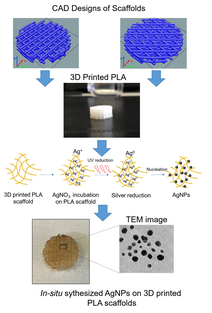Crossref Citations
This article has been cited by the following publications. This list is generated based on data provided by
Crossref.
Tan, Ezgi
Kahyaoğlu, İbrahim Mizan
and
Karakuş, Selcan
2022.
A sensitive and smartphone colorimetric assay for the detection of hydrogen peroxide based on antibacterial and antifungal matcha extract silver nanoparticles enriched with polyphenol.
Polymer Bulletin,
Vol. 79,
Issue. 9,
p.
7363.
Municoy, Sofia
Antezana, Pablo Edmundo
Bellino, Martín Gonzalo
and
Desimone, Martín Federico
2022.
Development of 3D-Printed Collagen Scaffolds with In-Situ Synthesis of Silver Nanoparticles.
Antibiotics,
Vol. 12,
Issue. 1,
p.
16.
Zhang, Qiang
Luo, Yang
Liang, Bo
Suo, Di
Lyu, Shang
Wang, Yi
and
Zhao, Xin
2022.
An anti-bacterial and anti-cancer fibrous membrane with multiple therapeutic effects for prevention of pancreatic cancer recurrence.
Biomaterials Advances,
Vol. 137,
Issue. ,
p.
212831.
Petousis, Markos
Vidakis, Nectarios
Mountakis, Nikolaos
Papadakis, Vassilis
and
Tzounis, Lazaros
2022.
Three-Dimensional Printed Polyamide 12 (PA12) and Polylactic Acid (PLA) Alumina (Al2O3) Nanocomposites with Significantly Enhanced Tensile, Flexural, and Impact Properties.
Nanomaterials,
Vol. 12,
Issue. 23,
p.
4292.
Shen, Bofan
Lu, Shulai
Sun, Chunfu
Song, Zhenbiao
Zhang, Fuyi
Kang, Jian
Cao, Ya
and
Xiang, Ming
2022.
Effects of Amino Hyperbranched Polymer-Modified Carbon Nanotubes on the Crystallization Behavior of Poly (L-Lactic Acid) (PLLA).
Polymers,
Vol. 14,
Issue. 11,
p.
2188.
Kumar, S. Pravin
Asokan, Yuvasri
Balamurugan, Keerthana
and
Harsha, B.
2022.
A review of wound dressing materials and its fabrication methods: emphasis on three-dimensional printed dressings.
Journal of Medical Engineering & Technology,
Vol. 46,
Issue. 4,
p.
318.
Asadollahi, Mohammad
Gerashi, Ehsan
Zohrevand, Mohammad
Zarei, Masoud
Sayedain, Sayed Shahab
Alizadeh, Reza
Labbaf, Sheyda
and
Atari, Mehdi
2022.
Improving mechanical properties and biocompatibility of 3D printed PLA by the addition of PEG and titanium particles, using a novel incorporation method.
Bioprinting,
Vol. 27,
Issue. ,
p.
e00228.
Mahmoudi, Masoud
Alizadeh, Parvin
and
Soltani, Mohammad
2023.
Wound healing performance of electrospun PVA/70S30C bioactive glass/Ag nanoparticles mats decorated with curcumin: In vitro and in vivo investigations.
Biomaterials Advances,
Vol. 153,
Issue. ,
p.
213530.
Cakmak, Hanife Yuksel
Ege, Hasan
Yilmaz, Senanur
Agturk, Gokhan
Yontem, Fulya Dal
Enguven, Gozde
Sarmis, Abdurrahman
Cakmak, Zeren
Gunduz, Oguzhan
and
Ege, Zeynep Ruya
2023.
3D printed Styrax Liquidus (Liquidambar orientalis Miller)-loaded poly (L-lactic acid)/chitosan based wound dressing material: Fabrication, characterization, and biocompatibility results.
International Journal of Biological Macromolecules,
Vol. 248,
Issue. ,
p.
125835.
Alli, Yakubu Adekunle
Anuar, Hazleen
Manshor, Mohd Romainor
Bankole, Owolabi Mutolib
Rahman, Nurul Amirah Abd
Olatunde, Simeon Kayowa
Omotola, Elizabeth Oyinkansola
Oladoye, Peter Olusakin
Ejeromedoghene, Onome
Suhr, Jonghwan
Sukindar, Nor Aiman
and
Nasir, Nur Aimi Mohd
2023.
Influence of nanocomposites in extrusion-based 3D printing: A review.
Hybrid Advances,
Vol. 3,
Issue. ,
p.
100069.
Anwajler, Beata
and
Witek-Krowiak, Anna
2023.
Three-Dimensional Printing of Multifunctional Composites: Fabrication, Applications, and Biodegradability Assessment.
Materials,
Vol. 16,
Issue. 24,
p.
7531.
da Silva, Daniel J.
Duran, Adriana
Fonseca, Fernando L.A.
Parra, Duclerc F.
Bueno, Rodrigo F.
and
Rosa, Derval S.
2023.
Omicron SARS-CoV-2 antiviral on poly(lactic acid) with nanostructured copper coating: Wear effects.
Applied Surface Science,
Vol. 623,
Issue. ,
p.
157015.
Robinson, Meghan
Sparanese, Sydney
Witherspoon, Luke
and
Flannigan, Ryan
2023.
Human in vitro spermatogenesis as a regenerative therapy — where do we stand?.
Nature Reviews Urology,
Vol. 20,
Issue. 8,
p.
461.
Liparoti, Sara
and
Pantani, Roberto
2024.
Reference Module in Materials Science and Materials Engineering.
de Albuquerque, Alisson S.
Vaz, Elaine C.R.
dos Anjos, Janaína V.
and
Santa-Cruz, Petrus A.
2024.
Active biosoluble composite material obtained by real-time LbL photoreduction of silver via light-based 3D printing.
Optical Materials: X,
Vol. 21,
Issue. ,
p.
100283.
Izadi, Razie
Das, Raj
Fantuzzi, Nicholas
and
Trovalusci, Patrizia
2024.
Fracture properties of green nano fibrous network with random and aligned fiber distribution: A hierarchical molecular dynamics and peridynamics approach.
International Journal of Engineering Science,
Vol. 204,
Issue. ,
p.
104136.
Essalhi, Mohamed
Khayet, Mohamed
and
Tavajohi, Naser
2024.
Polymeric Membrane Formation by Phase Inversion.
p.
199.
Astaneh, Mohammad Ebrahim
and
Fereydouni, Narges
2024.
Silver Nanoparticles in 3D Printing: A New Frontier in Wound Healing.
ACS Omega,
Vol. 9,
Issue. 40,
p.
41107.
Chen, Shunyu
Qiu, Zhoucheng
Zhao, Lihua
Huang, Xiaojing
and
Xiao, Xiufeng
2024.
Functionalized BP@(Zn+Ag)/EPLA Nanofibrous Scaffolds Fabricated by Cryogenic 3D Printing for Bone Tissue Engineering.
Advanced Healthcare Materials,
Ban, Seunghyeb
Lee, Haran
Chen, Jiehao
Kim, Hee-Seok
Hu, Yuhang
Cho, Seong J.
and
Yeo, Woon-Hong
2024.
Recent advances in implantable sensors and electronics using printable materials for advanced healthcare.
Biosensors and Bioelectronics,
Vol. 257,
Issue. ,
p.
116302.
